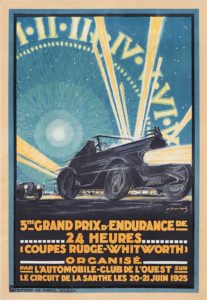Le Mans 24 Hours of 1925: A race to remember
The Grand Prix d'Endurance for the Rudge-Whitworth Cup. J.D Benjafield, of the Bentley team gives his account of the Le Mans 24 Hours race held on 20th and 21st June, 1925.
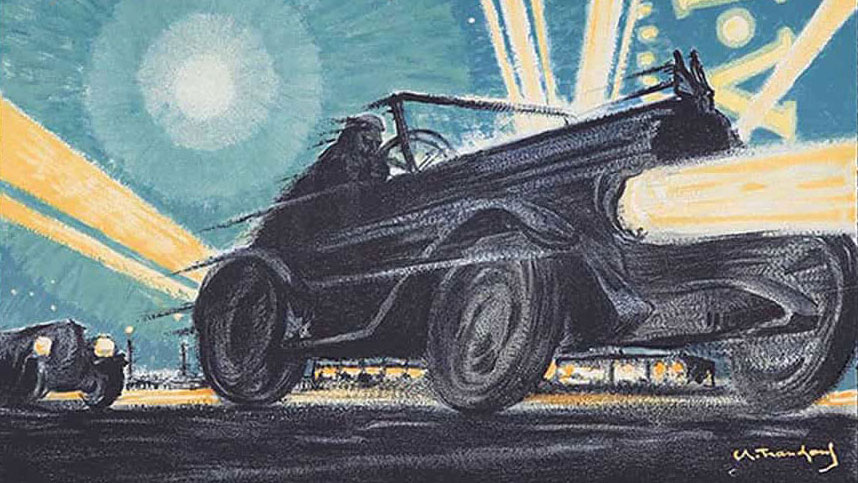
This, the greatest race for cars in touring trim, took place at Le Mans on June 20th, 1925, finishing 24 hours later. Arriving at the circuit six days before the race, one was immediately impressed by the forward state of the preparations, and, although the course was never officially closed, practice was proceeding more or less continuously night and day; one fears that the people whose houses abutted on the circuit enjoyed little sleep during this period, as most of the cars engaged had open exhausts, silencing regulations being noticeable by their absence.
Each lap of the circuit measures approximately 10 miles, and it is composed of a four-mile more-or-less straight leg with a slight down grade and good tarred surface, followed by a right-angled turn, and then winding road, including a severe S-bend, after which it straightens out and runs down to the famous Pontlieue hairpin, where it joins up with the straight leg once more.
Apart from the straight leg, the surface was poor, full of pot-holes, untarred, and, following the long spell of dry weather, easily torn up by the wheels, with the result that, when following another car at all closely, one did so under a hail of stones of all sorts and sizes. The day before the race all this section of the course was treated liberally with a solution of calcium chloride, which helped bind it together, and somewhat, at least, alleviated the dust.
The substantial grandstand was situated about halfway down the straight, and opposite it was the score board, admirably worked, where one could see at a glance the relative positions of the cars in the race. The pits were next to the score board.
The fact that the course was not closed did not appear to worry many of the continental drivers at all; they still proceeded down the straight with their foot gummed to the floor boards, and relied on their skill in steering to avoid the numerous obstacles. It was obviously only a question of time before somebody would endure a crash. One of the big Chenards was the first; hitting a stationary lorry, fortunately only the car was seriously hurt in the incident. However, on the Friday night preceding the 24-hours race, one of the Ravels was less lucky, hitting a lorry head on at some considerable speed, with the result being that three people were seriously injured.
The six days before the race were devoted to tuning, minor adjustments, and practice, and one’s time was fully occupied, the learning of a circuit of this type being no small task. We did it partly by driving, partly by walking, and the remainder by taxi. At last the great day arrived, and the few hectic finishing touches were made. Immediately after lunch we proceeded to the course, well armed with food, a lorry full of spares, and the two racing cars.
At 15:00hrs the order was passed along to line up for the start; the cars were placed on the right of the road opposite the grandstand in order of their size, the largest having the first place. They were staggered so that any individual could take the road as soon as ready. The drivers were all summoned to receive final instructions from the president of the A.C. de l’Ouest. Sharp to time the flag fell, and the loud speakers bellowed “Partez” when the drivers made a dash for their cars, feverishly erected the hood (20 laps having to be driven with the hood up), leapt in, pressed the starter, and away they went in a cloud of dust. John Duff was first away in his Bentley No.9, and the agility he showed in tucking his long limbs under the dash would have done credit to an acrobat. He was closely followed by Bertie Kensington-Moir in the other Bentley, No.10, and, needless to say, the cheers from the Bentley pits were long and loud, the omens being most favourable. They were closely followed by the Sizaire-Berwicke, a couple of 0Ms, Henry Segrave’s Sunbeam, and then a steady procession of cars, the last appearing in no hurry to get away, being nearly five minutes behind Duff.
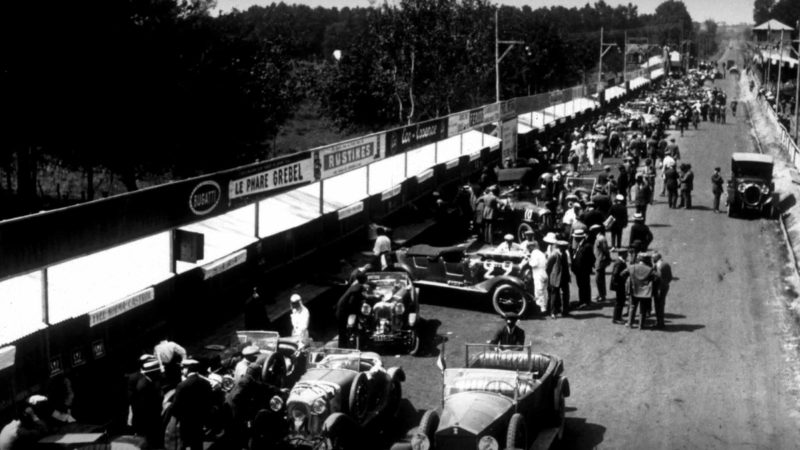
Never have the Le Mans pits looked so different to what we know now…
Nearly 10 minutes had elapsed before Segrave came roaring past, closely followed by Kensington-Moir, with Duff not far away in third. Hot on their heels were one each of the big Lorraine-Dietrichs and Chenard & Walckers. In these early stages the most notable feature was the Bentley-Sunbeam duel, both cars being admirably handled by their respective drivers, Moir and Segrave. Judging by the power of acceleration, the Bentley had a considerable reserve of power. Segrave retained the lead until the 11th lap was completed, but on the 12th circuit Moir had passed him, and was leading by a narrow margin, only to be repassed once more by Segrave on the next lap. On the 14th circuit Moir had once more recovered the lead, only to retain it for a short period, as on the next round he came into the pits to work on the oil filter cap, which had become detached and through which he was losing his supply of oil. Segrave’s Sunbeam had also suffered from a stuck throttle, and Jean Chassagne’s Sunbeam, which had been nursed with care, always within striking distance of the leaders, came in with similar trouble. Thus, the leadership, which had dwelt in British hands for the first 15 laps, passed into French hands, René Leonard’s Chenard-Walcker, closely followed by Henri Stalter’s Lorraine-Dietrich, with Duff’s Bentley third.
Moir and Segrave were soon going again, and rapidly commenced to overhaul the leaders. The relief drivers now began to get busy and don their war paint in the shape of overalls, goggles, etc, ready to take over their charges so soon as the first drivers should have completed the first 20 laps.
Clement and I, thus sitting in the Bentley pit, seeing No.9 disappear down the straight on its 20th lap, closely followed by No.10 on its 18th lap, watched with anxious eyes on the stopwatch awaiting their return. After 12 minutes, the last two of which seemed like hours, we were compelled to realise that something serious had stopped them. A further five, 10, 15 and 30 minutes, and then Duff suddenly appeared from the forest dusty, travel-stained and panting after a four-mile run across country from the opposite side of the track. His petrol pump had broken, and he had run across for spares. He once more disappeared into the forest. Shortly afterwards Moir arrived at the pits on foot; No.10 Bentley had run out of petrol within a mile of completing its 19th lap, and was therefore disqualified, being 12 miles short of the distance required before replenishments are allowed. Thus, through a miscalculation over the extra amount of fuel required to pull the car at speed with the hood up, the fastest car in the race, after putting up a remarkable show for 18 laps, was disqualified. After a considerable further interval, Duff reappeared in No.9, having lost 1.5 hours, and Clement leapt up, wasted little time in refilling, and thundered away into the dusk.
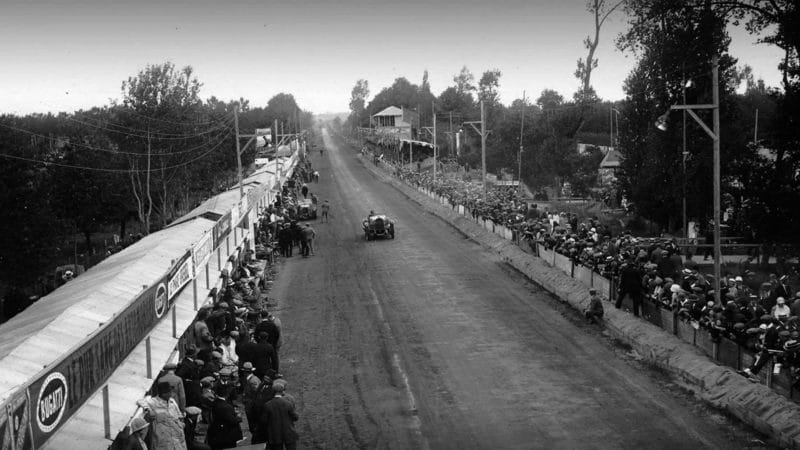
Rough roads and constant dust made conditions tough.
In the meantime, the strenuous conditions of the contest had taken a heavy toll on the competing cars, some being stopped by breakdowns, and others by crashes. The most notable in the latter class were the Amilcar, driven by poor Marius Mestivier, which overturned on the straight for some unexplained reason, killing its driver instantly, and one of the Lorraine-Dietrichs, which was overturned without serious injury to its driver. George Duller, who had taken over Sunbeam No.15 from Segrave, was compelled to retire after 30 laps with a seized clutch, and so at midnight only two of the British contingent remained, the Chassagne and Sammy Davis Sunbeam and the Duff and Clement Bentley. The latter proceeded to put in much good work, first in Clement’s hands and then in Duff’s, gradually reducing the long lead held by the large French cars. At 05:00hrs Duff once more handed over to Clement, and just as the position was becoming very hopeful, and No.9 was almost within striking distance of the leaders, the float-chamber of one of the carburettors snapped off, and the near side of the engine caught fire. Clement managed to extinguish this with the help of a cushion before much damage was done, but it was quite useless to attempt a repair owing to his distance from the pits. Thus the essential feature, ‘Luck’, without which all one’s efforts may be rendered futile, had deserted us and we were out of the race through two trivial details, and still in perfect mechanical condition.
And now in the early morning, chilly and misty, the race had resolved itself into a contest between the two large Lorraines, the Chassagne-Davis Sunbeam, and the two little Chenard-Walckers. Was it possible for the larger cars to cover the greater distance required by the handicap than these two Heath-Robinson, beetle-backed affairs with one thousand million bees under their bonnet, that appeared to be screaming round the circuit with extreme regularity and phenomenal speed? No, they must crack, no engine could stand these revs indefinitely; one listened in vain for any faltering in their exhaust note. The Diattos, too, were running with extreme regularity, although not quite fast enough to be up with the leaders. The one and only American car, the Chrysler, was also, although rather slow, putting in some very steady work.
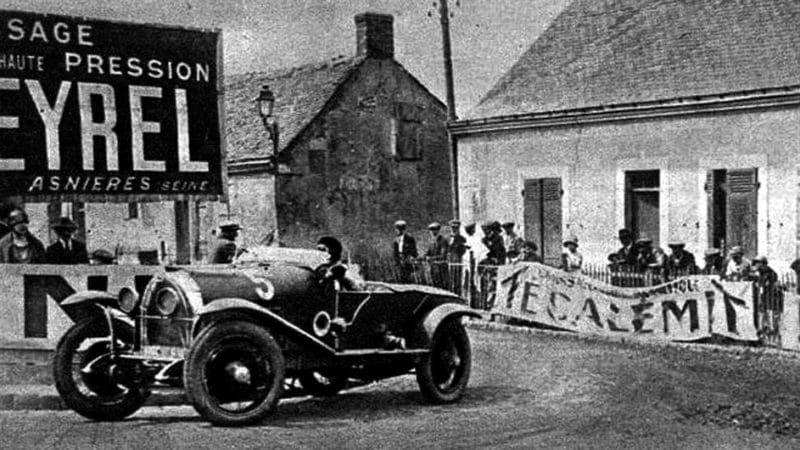
The winning Lorraine-Dietrich driven by André Rossignol and Gérard de Courcelles, which was four laps clear at the finish.
As the closing stages approached, it appeared obvious that, apart from accidents, the little Chenards must win the formula prizes, the only question being whether the Sunbeam could wrest first place for the greatest distance from the Lorraine, driven by Gérard de Courcelles and André Rossignol, and also keep ahead of the other Lorraine, which was less than a lap behind. At 16:00hrs the position was unchanged, and the Sunbeam had to acknowledge defeat, only to the Lorraine-Dietrich, by approximately 45 miles, beating the other Lorraine into third by about eight miles.
And so the end of a very fine contest, amongst much hand-shakings, embracings and bouquets, all weary, spectators, drivers and mechanics alike, some happy and some not, but with a grim determination to try again, and with, perhaps, more success in captivating that fickle jade, “Good Luck.”
Before leaving the subject, let us tender our sincere thanks to the organisers and officials of the race for their courtesy, assistance and fairness, and our heartiest congratulations for the admirable way in which the whole affair was run. Also, from the spectators’ point of view, everything was admirable; food and drink of all varieties being available in quantities, counter-attractions in the shape of dancing and boxing bouts throughout the night for those who should temporarily weary of the race.
The moral for the next time is that we require a compromise between the tortoise and the hare for a race of this character, it being useless to save 10 seconds a lap, if by doing so one is going to lose an hour after 30 or 40 laps for mechanical repairs. Last, we owe thanks to the weather, for not a single spot of rain fell during the whole period occupied by practice or the race.
Originally published in Motor Sport, August 1925
